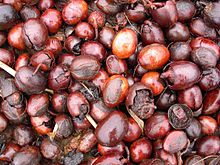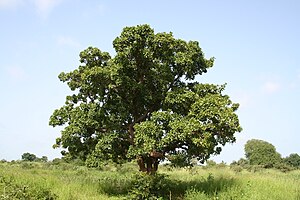Vitellaria
| Subclass of | useful plant |
|---|---|
| Short name | V. paradoxa |
| Taxon name | Vitellaria paradoxa |
| Taxon rank | species |
| Parent taxon | Vitellaria |
| Taxon synonym | Butyrospermum parkii |
| This taxon is source of | shea wood, shea butter |
| IUCN conservation status | Vulnerable |
| GRIN URL | https://npgsweb.ars-grin.gov/gringlobal/taxonomydetail.aspx?id=102598 |
Vitellaria paradoxa (formerly we know am as Butyrospermum parkii), ebi popularly known as shea tree, shi tree, or vitellaria, ebi tree for Sapotaceae ein family. Ebi de only species wey dey genus Vitellaria,[1] den ebi indigenous give Africa.
De shea fruit dey consist of thin, tart, nutritious pulp dat dey surround am relatively large, oil-rich seed from which shea butter bi extracted. Ebi deciduous tree wey usually 7–15 m (23–49 ft) tall, buh ein reach 25 m (82 ft) den ein trunk diameter bi 2 m (6.6 ft).
De shea tree bi traditional African food plant. Dem dey claim say egey potential say ego fi improve nutrition, boost food supply insyd de "annual hungry season",[2] foster rural development, den support sustainable land care.[3]
Description
[edit | edit source]De tree mostly dey start bear ein first fruit wen egrow lyk 10 to 15 years old; ein full production bi wen de tree gey about 20 to 30 years old. Ebi den wen edey produce nuts for lyk 200 years.
De fruit dey rep large plums 4 to 8 centimetres long wey dey weigh between 10 den 57 grams each.[4] Dese fruits dey take lyk 4 to 6 months for am to ripe; ein average yield bi 15 to 20 kg (33 to 44 lb) of fresh fruit per tree, wid ein optimum yields bi up to 45 kilograms (99 pounds). Each kilogram of fruit dey give approximately 400 grams (14 ounces).) of dry seeds. De fruit bi edible.
Subspecies
[edit | edit source]- Vitellaria paradoxa subsp. nilotica (Kotschy) A.N. Henry & Chithra & N.C. Nair -Cameroon, Mali, den Burkina Faso[5][6]
Distribution den habitat
[edit | edit source]De shea tree dey grow naturally insyd de wild den dry savannah belt for West den South from Senegal insyd de west to Sudan den South Sudan for de east, den onto de foothills for de Ethiopian highlands. Edey insyd 19 countries across African continent, dem bi Benin, Burkina Faso, Cameroon, Central African Republic, Chad, Ethiopia, Ghana, Guinea Bissau, Ivory Coast, Mali, Niger, Nigeria, Senegal, Sierra Leone, South Sudan, Sudan, Togo, Uganda, Democratic Republic of de Congo, den Guinea. Ein habitat area dey spans as wide as 5,000 square kilometres.[7]

De testa dem find for de site of de medieval village of Saouga bi evidence say shea butter production dey go on insyd14th century den tyms all.[8]
Uses
[edit | edit source]Shea butter gey plentey uses if ebi refined or naa, manners dey use am. Insyd de West ebi de most commonly used as demma emollient insyd de cosmetics industry insyd den dem san use am insyd food. Throughout Africa dem dey use am extensively for food insyd, ebi major source for dietary fat, den for medicinal purposes. Insyd Ghana den Nigeria, shea butter bi demma major ingredient for making demma African black soap.
De edible protein-rich caterpillars for de moth Cirina butyrospermi wey edey feed solely for ein leaves wey dem dey widely collect am den eat raw, dried or fried.[9]
Composition of shea butter
[edit | edit source]
Shea butter extract bi complex fat wey san gey nonsaponifiable components (substances wey eno be fully convert am into soap by ein treatment plus alkali) wey edey contain de following fatty acids: oleic acid (40–60%), stearic acid (20–50%), linoleic acid (3–11%), palmitic acid (2–9%), linolenic acid (<1%) den arachidic acid (<1%).[10] Edey contain de vitamins A, E den F.
Etymology
[edit | edit source]
Dis bi de origin for de English word, wey ein primary pronunciation bi /ʃiː/ (rhyming with "tea"), although ein pronunciation bi /ʃeɪ/ (rhyming with "day") bi common den ein list for de second insyd major dictionaries. De tree bi called ghariti insyd de Wolof language of Senegal, wey ebi de origin of de French name for de tree den de butter, karité.
Insyd Hausa language de tree dem dey call am Kaɗe or Kaɗanya. Indeed, de shea tree bi indispensable insyd Mole-Dagbang culinary den ethno-botanical practices dat de Northern Ghanaian city for Tamale etymologically wey gey ein name from de more traditional Dagomba name 'Tama-yile' (wey edey mean 'Home of Shea nuts').
Formerly, dem dey classify de tree insyd de genus Butyrospermum, wey dey mean "butter seed". De species name parkii honors Scottish explorer Mungo Park, who dey learn am of the tree while dem dey explore am for Senegal. Park's Scottish origin dey reflect am insyd de English word shea.
References
[edit | edit source]- ↑ http://www.worldagroforestrycentre.org/sea/products/afdbases/af/asp/SpeciesInfo.asp?SpID=394
- ↑ http://www.fao.org/docrep/008/y5918e/y5918e11.htm
- ↑ http://books.nap.edu/openbook.php?record_id=11763
- ↑ https://doi.org/10.1080%2F10408398.2011.604142
- ↑ https://doi.org/10.1007%2Fs10722-012-9905-8
- ↑ https://web.archive.org/web/20230419041419/https://agris.fao.org/agris-search/search.do?recordID=AU2019109125
- ↑ http://www.fao.org/3/y5918f/y5918f11.htm
- ↑ https://doi.org/10.1007%2FBF01373925
- ↑ https://en.wikipedia.org/wiki/Vitellaria#cite_note-10
- ↑ http://agritrop.cirad.fr/556466/

